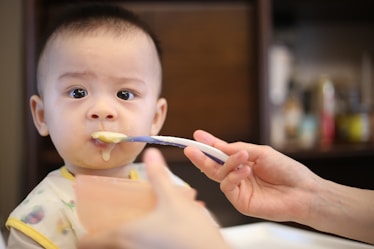
First published: 27 December 2021 @ 6:00 pm
Breastfeeding is the most natural way to feed a baby and offers many health benefits, including immunity protection, improved cognitive development, weight gain and reducing the risk of allergies.
Breastfeeding also promotes bonding between mother and child. Baby-led weaning is an alternative to the traditional weaning approach of introducing solids to your baby.
The Baby-led weaning approach is where your baby learns to eat on his or her own, while still being fed by you at mealtimes. Baby-led feeding can be started at around 6 months of age or later if you prefer.
It encourages the transition from breast milk to solid foods in a more natural way than with traditional spoon-feeding. The baby-led weaning involves the infant feeding itself with finger food instead of spoon-feeding it from a bottle or tablespoon.
What’s so great about this baby-led approach?
1. Baby-led weaning can be fun for both parents and babies.
With a baby-led approach, you can have fun with your baby by making mealtime a positive experience. Try to give them choices, so they can feel involved in what they are eating.
Give them an opportunity to see what is being served before they eat it, so they have a chance to decide if they want to eat it or not.
Try to involve them by using hand signals, talking and making eye contact with them while offering them food items like avocado, banana, pasta or other foods that you think are easy for them to eat.
You can also involve them by asking them questions like “Do you want to eat this?” or “Do you want to try this?”
This alternative method is a way for parents and babies to have an emotional connection with each other.
2. Prevent Bloating
Bloating occurs when a baby eats too much or too fast in one sitting. The sudden influx of food can cause gas in babies, which may lead to diarrhoea and dehydration, if not prevented in time.
In order to prevent bloating, you can introduce your baby with small pieces of food one by one over several days instead of giving them all at once when they are hungry.
This is why baby-led feeding is considered as a good option for preventing bloating and gas formation in babies because they are introduced with small pieces of food slowly and steadily instead of big chunks or full portions at once.
3. Encourage Baby’s Interest in Nutritious Food
Introducing a wide range of foods to a baby is an important step in teaching them how to eat and feed themselves.
When babies are fed with the help of a caregiver, they usually don’t take any interest in food until they get older and even then, they might not like to eat their healthy food.
On the other hand, when they are introduced to new foods on their own, they tend to take an interest in them and learn more about them, thus giving them a positive attitude towards eating.
4. Help Baby Develop Healthy Eating Habits
Baby-led weaning helps develop healthy eating habits in babies since they learn how to eat baby food and feed themselves at a slow pace and at their own pace before they get the chance to do so on their own.
In addition, this method helps children develop the habit of eating slowly since the process of learning is done slowly but surely.
This can help prevent overeating or over-eating from happening when children start eating solids on their own after 2 years old. In this way, baby led weaning can be a good way to develop healthy eating habits in children.
5. Improve Baby’s Motor skills
Babies who are not given the chance to explore their environment on their own often tend to lack motor skills, which can be due to the fact that they are not given the chance to practice with objects or by themselves.
This means that they will have difficulties interacting with others, learning how to walk and so on. Baby led weaning helps improve motor skills since it helps babies learn how to manipulate objects and people at their own pace.
When babies are introduced to new food items at a slow pace, they can develop fine motor skills, which will help them interact better with other people or objects.
What are some things that you need to know about baby led weaning?
It’s important that you’re aware of some important facts about this feeding method before you decide whether it’s right for your family:
It can be hard to do
If you’re not used to handling family food yourself, then this approach to infant feeding may be a challenge for you.
You’ll need to practice by following your baby or toddler as they eat solid foods, and then gradually moving onto the next step as they become more comfortable with their mealtime routine.
Keep in mind that some children may refuse certain foods at first, which is completely normal and just means that they’re not ready yet for those particular foods. Try your best to remain patient with them during this process.
Your child may dislike certain foods
When you start baby-led approach, your child may not like the taste of some of the new foods that he’s trying out. It’s important to encourage him to try this variety of foods and remind him that he can always ask for more if he doesn’t like it.
If you see any signs of food allergies, stop feeding them immediately. It’s also possible that your child will be hesitant about trying certain regular foods at first because they’re bitter or strong tasting.
This is completely normal and won’t harm him. The best thing you can do is give him lots of praise and reassurance when he tries the new food.
You’ll need to teach your child how to eat
While baby led weaning is a great way to introduce solid foods into your child’s diet, you’ll still need to teach them how to eat those foods properly as they get older.
It can be frustrating if your child refuses a particular food, but don’t give up on this feeding process too quickly — these setbacks are all part of the learning process.
Your child will eventually get the hang of eating certain foods and be able to eat them without any problems.
What to Feed Your Baby?
As mentioned above, baby-led weaning is a way for you to introduce solid foods into your child’s diet while he learns how to handle them himself. You’ll need to slowly add new types of foods to his diet over time, starting with the easiest ones. The following are some foods that you can start with:
Weaning foods
These are the foods that your child will learn to eat first. These foods should be relatively soft and easy for him to chew. Some examples of weaning foods include rice cereal, bread and pasta.
Weaning vegetables
As your child learns how to eat more complex foods, you can start introducing more vegetables into his diet as well. You can do this by mixing them into other food items or simply giving them as a side dish with your main meal. Vegetables that you can introduce include carrots, broccoli, cauliflower and Brussels sprouts.
Weaning fruit
You can start introducing your child to fruit when he’s ready. This includes apples, bananas, oranges and other fruits that are softer than hard vegetables.
Weaning proteins
You can introduce your child to meat and other protein-rich foods at the same time as the vegetables. The meat includes chicken, turkey and beef, while fish can be added to his diet as well. Some examples of other proteins include tofu, eggs and beans.
Weaning sweet foods
When your child is ready for this step in his diet, you can introduce him to some types of sweet foods such as cookies or yogurt that are made with sugar or honey instead of fruit juice or syrup.
These should be eaten in moderation so that they don’t become a substitute for healthier options like fruit or vegetables instead of an occasional treat once in a while.
Baby-led weaning can be an extremely effective way to introduce solids and introduce new foods. It allows parents to spend more time with their child and develop a better relationship. In addition, this method improves oral motor skills.
Learn more about parent-children activities, how to improve your children’s motor skills, and many more on Mature Parent blog!





